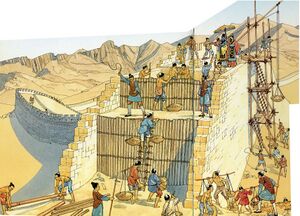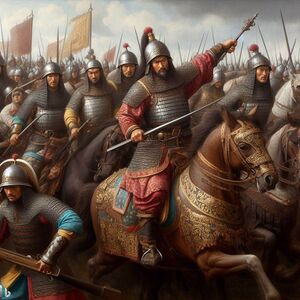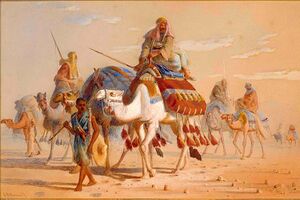United Cities
United Cities 联合城市 | |
|---|---|
| 915 CE-1215 CE | |
|
Flag | |
 Maximum extent of United Cities territory | |
| Capital | Heng |
| Government | Plutocracy |
| Grand Magister | |
| Legislature | Council of Magisters |
| Today part of | |
The United Cities was a state that existed in northwestern Daxia and parts of Canpei from 915 to 1215. Emerging during the death throes of the Chen dynasty and the Four Great Impostors crisis, it was originally created as a confederation of city states, the main aim of which was mutual protection, eliminating bad governance, promoting the slave trade and evading imperial taxation. The original members were the cities of Heng, Sho Battai, Brink, Heft and Stoat. The economy of the United Cities was reliant and heavily dominated by the practice of slavery, only a few decades after its founding did its political system come to be dominated by powerful slaver interests, effectively creating a highly corrrupt and despotic plutocracy. The United Cities would fall to Daxian Zhong dynasty armies in 1215 but many of its trade and societal practices would continue in the territories that it had ruled.
History
Formation and Early Period (915-1000)
The reigning Chen dynasty of Daxia saw a succession of revolts and uprisings starting in 877. The rise of the Four Great Impostors who sought to claim the imperial throne posed an existential threat to it. The second of these pretenders, Tengu Peg Leg, first rose in the city of Heng in 896. Claiming descent from the last Shang emperor, he and his supporters took over the city administration by force and gained the support of its citizens by abolishing taxes for three years and promising to give every citizen five slaves from towns he conquered. Other cities in the region expelled their imperial garrisons and approached Tengu for protection and relief from imperial taxation . With these defections the territory controlled by Tengu's loyalists grew to cover all of the Daxian northwest. He declared himsef emperor with Heng as his capital and styled his domain as Northern Shang. The loss of important economic centers like Heng and control of important trade routes to the north represented a heavy blow to the Chen dynasty's finances and hobbled its capacity to respond quickly.

Alarmed by the rapid rise of Tengu and the rapid defection of the northwest provinces to him, the weakening Chen dynasty appointed a certain nobleman named Da Beipan, who would later found the Zhong dynasty, to the post of Titanic Captain of the West to deal with the rebellion. Da Baipan mustered and trained his imperial forces of roughly 130,000 men for six months before moving his army into Tengu's territory. Da Baipan proceeded to invest the walled city of Sho Battai, attempting to storm the city twice but being repulsed. Settling on starving the city out, he was confident that Tengu's army was smaller than his own and would not approach to give him battle. This would prove to be a mistaken assumption as Tengu's 200,000 strong army force marched its way towards Sho Battai barely two months into the siege. Despondent at being so outnumbered and with the possibility of being pinned against Sho Battai's walls, Da Baipan abandoned the siege and began making his way back to Zhong territory. Overtaken at the Catun Fields, the vanguard of Tengu's army clashed with the imperial force, badly mauling it and sending it running from the field. After this defeat, Da Baipan offered a ten year truce with Tengu, swearing that the Chen dynasty would pay indemnities to him. More concerned at the time with consolidating his rule than territorial expansion, Tengu accepted the truce and allowed Baipan's army to leave unmolested. Knowing his failure would cost him his life and even after the Catun Fields defeat, in posession of one of the largest imperial field armies, Da Baipan turned traitor and began marching his army to the imperial capital to overthrow the Chen dynasty. Secure for a time against his most dangerous external foe, now Emperor Tengu would spend the next decade attempting to centralize power and have a greater power over the cities and local taxation. Feeling they had exchanged an autocrat far away for one at home, the elites of Heng and many cities began to resent Tengu's rule and withold funds from his tax collectors. In the winter of 915, a mob of peasants paid for by Heng's nobles attacked Tengu and his attendants on the streets. While Tengu's outnumbered guards attempted to hack their way out of the mob, a farmer with an axe hewed the emperor's peg leg below the knee causing him to stumble to the ground where he was stabbed to death. After merely 19 years in power, the childless emperor and his dynasty were overthrown as suddenly as they had risen. New Magisters drawn from the old nobility rose in every major city, agreeing to maintain their ties as a loose defensive union that would collectively come to be known as the United Cities.
Following the fall of the Chen dynasty and the rise of the Zhong, the United Cities signed a treaty of alliance with the Degei confederation under Darukh Khan. The United Cities provided funding to the tune of two hundred tons of silver plus ten thousand men from the Iron Legion under Warmaster Shin for Darukh Khan's invasion of Zhong territory. The war would extend itself for ten years and initially went well for the alliance. Darukh Khan's poisoning in 927 CE by a group of rival chiefs after battlefield reversals would lead the United Cities to pull off their support entirely and make separate peace arrangements. However the peace reached was shaky at best and recriminations broke into renewed conflict in 940 when the Zhong invaded ostensibly to free Zhong citizens captured and sold into slavery in the United Cities. The military fiasco that was the intervetion in favor of Darukh Khan left a lasting negative impact on the political stability of the United Cities. The military losses weakened several cities and led to an increase in brigandage. During the 930's and 940's, the Council of Magisters deposed several Grand Magisters for various reasons. The unity of the alliance was seriously compromised when armed hostilities broke out between Sho Battai and Brink. The defeat of Darukh Khan's attempt to conquer Daxia left the United Cities in a perilous position. Despite having withdrawn their support before war's end, the Zhong dynasty had no intention of letting the magisters off the hook for their participation and bankrolling of the war. Emperor Gong did was not able to punish the United Cities as he died in 926, his son and successor Mong began reconstruction of the devastated northern provinces and planning what would be the first of the Zhong-United Cities wars in revenge. While circumstances in Daxia aligned towards war, the cities of Brink and Sho Battai engaged in vicious skirmishes over control of the main slave trade route to the northwest. The fighting was not quelled until the Grand Magister Gashui himself marched the Iron Legion north and threatened to intervene if the two cities did not begin to negotiate. Sho Battai's and Brinl's truculent rulers finally made peace, judging that it was cheaper than being blockaded from the slave trade altogether. Gashui's spies in Daxia assured him that Emperor Mong's preparations would be ready within by the summer of 934. To counteract the stretched manpower resources at his disposal, Gashui chose to employ once more the Grand Company of the Virtuous Worms and other mercenary groups as Tengu Peg-Leg did before him. Ganshui also acquired fifty war elephants from the west bedecked in sheets of steel spiked armor.

Emperor Gong's awaited campaign finally began as had been predicted by the spies of the United Cities but the army fielded was much larger than previously anticipated, standing at some seventy thousand men under arms. Something the Daxians neglected was acquiring local allies, Sho-Battai's rulers at the time were willing to betray the United Cities and go back under Zhong rule. Emperor Mong's envoys haughtily rejected these overtures, claiming that they would simply have the city's surrender in good time. This attitude proved to be a great blunder and sent Sho-Battai back into anti-Zhong camp, there would be no northern thrust to divide the forces of the United Cities. The Zhong army entered enemy territory from the east and made its way methodically west to cut off the main road through which most trade passed from Heng. The first open battle took place in August 934 east of Stoat where the vanguard of the Zhong army was ambushed by the Iron Legion as they traversed a road next to a river. Unable to flee, most of the five thousand Zhong vanguard was pushed into the river were hundreds of men and horses drowned. This defeat stopped the Zhong drive on Stoat for the meantime. The forces of the United Cities went on the offensive with nightly raids on Zhong camps, utilizing their Wangdi corps and their rockets to set fire to the camps and scare the enemy horses into panicking without risking their own men at close range. Impatient and frustrated by the constant harassment tactics, the emperor turned his army back south and headed to Heng intent on laying siege to it. By this time the city had been well prepared and stocked with provisions for an attack. Secondary earthen and stone fortifications ringed the city's actual walls, tunnels for attack and defense had been dug as well as emplacements from where to rain rockets on the enemy forces. Zhong forces used catapults to launch corpses into the city in hopes of starting a plague that would sap its defenses. The were fierce attempts to capture the southern northern Yellow Gate which were only repelled when the defenders drove their elephants out through the gates and barreled down into the enemy ranks.
Middle Period (1001-1120)
Decline and Dissolution (1121-1215)
Geography
Climate
The predominant climate of the area covered by the United Cities is cold semi-arid, featuring warm, dry summers and freezing winters with temperatures dropping below zero. Winters usually see light to moderate snowfall.
Government
The United Cities was ruled by the Council of Magisters, a collection of the wealthiest and most influential men of each city who gathered in Heng's Hall of Wonders to deliberate on issues of collective concern. Only the richest ten citizens from each city were allowed to take part in the council. The choosing was not through election but by a tallying of the monetary worth of the aspirant, usually carried out by teams of Traders Guild accountants and auditors. Every ten years a member of the council would be elected by simple majority to serve as the Grand Magister of the United Cities. The Grand Magister had powers to represent the United Cities in foreign matters and trade negotiations and to set the agenda of the Council of Magisters. For the United Cities entire three hundred year existence the position was typically rotated, with no city ever holding on to the position for consecutive terms as per the founding pact. The Grand Magister had few domestic powers and served more as a coordinator and mediator for the cities; border conflicts and trade disputes were common in the United Cities and he had the power to settle the issues, if both parties agreed. Each city was mostly autonomous and had its own hierarchical governing structures and ruling families, though bound to ordinarily loosely adhere to the decisions of the Council of Magisters . One area where the Grand Magister had full authority was control of the military in times of war or natural disaster.
Military

The United Cities kept a unified standing army known as the Iron Legion, composed of twenty thousand men in lamellar armor, divided into footmen, cavalry and siege corps. It was augmented by city self-defense forces, private militias composed of slaves and hired mercenaries as needed. The troops of the Legion were renowned as experts at sieging fortifications and also at building defensive works. The Iron Legion also pioneered the world's first dedicated rocketry force, the Wangdi Corps. Artificer made rockets that could be deployed and fired by only one or two soldiers to contraptions that could fire dozens of rockets at a time were instrumental in the Legion's battle order.
The Iron Legion was able to repel the numerically superior armies of the Zhong for many years until reduced funding, corruption in the military leadership and the accelerated intake of slaves into its ranks drastically reduced its combat effectiveness and morale. Highly combat efficient in the first hundred years, the force began to experience a marked decline by the mid 1100's when the model of slave-soldier was permanently adopted for cost reasons. By 1215 the Iron Legion was a force more suited to putting down slave revolts than defeating another army in the field and it showed in the final war that ended with the obliteration of the United Cities.
Economy

The United Cities economy was heavily reliant on slave labor for its agricultural and industrial manpower. Slavers would undertake great raids into Rusana, Tashi-Daypa and the rest of Zhong dominated Daxia to procure slaves for both internal use and for export. It would also acquire Audonian slaves through intermediaries since the United Cities never had direct access to the sea. Many of the wealthiest citizens of the United Cities ammassed great fortunes and accompanying political power through the slave trade, at the expense of damaging relations with neighboring nations. The Grand Menagerie of Heng was the largest slave market in all of Alshar, it could house twenty thousand slaves in its halls and hundreds of auctions took place everyday.
The semiarid climate made for poor agricultural output, crops that required little water like cactus, date palms, mint and drought resistant legumes were favored. The rare alcoholic Cactus Rum has its origins in the United Cities and was also a big hard currency earner; the state owning the largest breweries in Heft. Another source of revenue was taxation of caravans traversing through its territory, during times of peace with the Zhong this was very lucrative for the state. Most trade in and out of the United Cities was overseen by an institution known as the United Traders Guild.
Culture
Hunting was an important aspect of upper class culture in the United Cities. The nobles of the United Cities were avid participants of numerous hunts in the deserts were they hunted great beasts such as sand elephants and the great Krayt dragons of old while at the same time socializing and bonding. Once a year the slaver houses would release hundreds of slaves into the deserts and hunt them down for sport, they called this the Desert Lottery. Those that made it outside the territory of the United Cities would gain their freedom. Over time cruelty against those of a lesser station became ingrained in the mentality of the upper classes. Teaching children that slaves were lesser humans was very common in the United Cities, one notable case was that of the child slave-lord Anundak the Red, a boy of twelve that upon inheriting his father's fortune and slaves, ordered half of them to lose a foot since he found it humorous to see the slaves hopping about on one foot.
